The History of Tumblr
How One Website Confused a Generation Of Girls With Woke Propaganda and Gender Ideology
(Note: I have to start making a bit of money from the site, so I’m going to put this brilliant piece by Laura behind a paywall just for a short time. If you can’t afford the subscription at the moment, don’t worry, this one will keep for a few days. It’s a brilliant record of how Tumblr created a feedback loop of anxiety and mental illness among many of its young users.)
I joined Tumblr in 2011 when I was 14. Back then, it was the place for hipsters to share their Urban Outfitters fashion, post rage comic memes, troll people, repost cat GIFS, and curate their aesthetics blogs with moody black and white photography. I joined because the hipster, one-year-away-from-coming-out-as-gay, boy I liked told me he and his friends were on it.
As an eccentric social outcast and pop culture skeptic, I was hesitant to try anything new, modern, or based in social media, but in an attempt to have a social life and counter my anxiety, I made a Tumblr account with the URL screaming-for-vengeance, my emo identification with the 70s/80s heavy metal album by Judas Priest.
I immediately saw that Tumblr was nothing like Facebook. Tumblr was cool, laidback, underground, and only people who knew, knew about it. It had a dark navy-blue layout and interface that encouraged anonymity through identification via icons and urls that were never supposed to be one’s actual real human name or face. It was a backdoor social club where everyone was encouraged to keep it secret from “normies” or most people who used Facebook, like parents, family, or the average person from school.
When I first posted on my Tumblr blog I felt like I was sending random messages out into the universe, with nothing being off limits, too unconventional, or off the wall to say. It was the perfect place for someone like me who felt too anxious to speak up in person, but who had a reservoir of jokes and funny observations waiting to be shared. Like most teenagers, my biggest passion was music and the artists who created it, but as a middle schooler in 2011, my music taste of exclusively old male rock stars from the 70s and 80s hadn’t earned me many social points over the years. Tumblr was my haven to connect with other weird girls who were also obsessed with Bruce Dickinson, finding new old photos of Led Zeppelin, and making memes about Peter Gabriel vs. Phil Collins era Genesis.
(Phil, BTW.)
For the first time ever, I was a popular member of a social group, where people appreciated me for my humor, taste, opinions, and values. I practiced my self-confidence by making webcam videos fangirling over Styx songs for my Tumblr friends and learning how to interact with people in ways I was missing out on at school. It was likely seeing my posts on Tumblr that helped me to make real-life friends with my crush and his friend group in high school, as I didn’t have the confidence to express myself in person as I did online.
As much as I owe Tumblr for helping my social life, confidence, and creativity, I am
only speaking about these positive attributes to illustrate how and why a young person might find a home on Tumblr, only to then be exposed to antisocial spaces and content. Because for every aesthetic photo of a girl in an oversized hoodie sitting under a neon light smoking a cigarette, there’s a photo of another photo of a girl with a caption over it about how she will never be good enough. For every meme about an anime rat, there’s a meme about how cis straight people need to be exterminated. For every text post teaching young people about some random kooky historical event, there’s a text post about how capitalism has corrupted everything to the point where nothing matters at all and it’s admirable to be a depressed piece of shit.
For example, as I was writing classic rock fanfiction requests for my mutuals at 16, my younger sister was finding aesthetic self-harm imagery that caused her to start cutting her arms in middle school. All the time I spent snickering at extensive threads of clever meta-memes that critiqued Tumblr culture and its users, I was also learning that part of Tumblr culture was unrestrained emotional reactivity, hyper-policing of wrongthink, and an incessant, cavalier attitude of self-defeatist humor and behavior.
While I believe Tumblr started as a platform for alternative free expression, especially for all variety of geeks and outsiders, including the LGBT community, Tumblr founders and users did not predict the shift from fun, afterschool, online social engagement, to 24/7 demi-existence immersed in the increasingly anti-social digital universe of the platform. There were jokes about how Tumblr was addicting and how it was sometimes more of a welcoming and friendly place for introverts and socially awkward people than real life spaces, but it was always discussed in terms of how inclusive and positive it was that the fandoms could nerd out about tv characters’ romantic tension, or how gay people could find and support each other.
Somehow, Tumblr underwent a transformation. It shifted from a slightly awkward but charming and highly supportive community for diversity and same-sex equality, culminating in the unanimous celebration of the 2012 legalization of gay marriage in the United States. However, it has now become a collection of echo-chamber niches dominated by woke social justice ideology, leaving little room for nuance or authentic diversity of thought.
I experienced its development from a quirky avant-garde website encouraging people to be weird and creative and have access to alternative methods of knowledge and learning, to a place where it was considered obligatory to list your privileges, pronouns, disabilities, diagnosis, and sexualities in your profile, or you might be considered problematic.
aka: Toxic, racist, sexist, misogynistic, homophobic, transphobic, biphobic, lesbophobic, enbyphobic, ableist, classist, capitalist, a Nazi, bigot, conversative, alt-right, hateful, narcissistic, and worst of all: An Ignorant Straight White Male, or just as deplorable: A Sympathizer, for any of those unacceptable types of people.
On Tumblr (and other internet spaces), it wasn’t just exposure as a problematic person with problematic views or behaviors, that was unacceptable. Virtually any hint of allegiance with a called-out or canceled group, or any slight past involvement or incidence of toxicity could and would be distributed digitally for collective public shaming. The no-win culture of toxicpersonhood was especially evident in this space because humiliation often did not stop even when the shamed party confessed to their wrongdoing, promised to do better, unlearned their toxic behaviors, or provided examples of positive character development.
Rather, the shame cycle would reignite upon the whim of the accusers. Each fresh assault could be undertaken at any moment, either for recreational reasons or to showcase supposed moral superiority. The threat of it was what kept others in line. If a user deleted their account, this was the ultimate sign of victory for the accusers because it served as tangible proof of their victim's guilt, and was used as evidence of their wrongdoing and cowardice.
This was the social culture young people were using on Tumblr to monitor each other’s negative behavior, but what then, was the behavior viewed as positive and celebrated? As I experienced, it used to be those who were original and clever who became popular based on funny text posts, or unique blogs which created GIFS and fandom materials for public use. While I can attest that there are still a variety of blogs creating beautiful artwork, posting witty puns, and providing helpful mental health or student resources, the overall culture of the site is now one of political and social Queerness.
Queerness.
In 2021, Tumblr Declared Itself as One of The Queerest Places on The Internet
I suspect that like many lesbian, gay, and bisexual organizations, communities, and supporters, once the hard-earned battle of same-sex marriage legalization in the America was won, there was energy to keep civil rights momentum and resources flowing positively for the community, a closing gap of notable community needs, and a growing number of people feeling comfortable coming out and creating visibility for their sexual and gender related issues. While this was happening widely, because Tumblr had always been ahead of the curve on LGBT acceptance, it was no longer radical or quirky to be homosexual, or gender non-conforming. Instead, most attention turned to the tagalongs of the LGB movement, the T’s.
Part of the push for trans-obsession may also have been inspired by the suicide of Leelah Alcorn, a 17 year old boy who identified as a trans girl, who published his suicide note on his Tumblr account in 2014.
Like many of our bravest fallen gender warriors, I learned about being trans and about “gender identity” on Tumblr when I was 15. It was so commonplace to have a progressive understanding about homosexuality vs. heterosexuality, and about basic feminist ideas regarding gender roles and stereotypes, that this new concept of gender identity felt like the next logical step towards understanding gender and sex issues. Being introduced to The Genderbread Person was enlightening to me as someone with an open-mind eager to soak up as much introspective awareness of myself and my identity as possible. It felt illuminating to explore the potential of my gender expression seeing as how I had always been non-conformist, and gender was one of the ways that individuality was most apparent.
As many detransitioners relay, Tumblr conveyor-belted me and other users along from generally-weird-precocious-intellectually-curious-divergently-minded-liberal-valued-naïve-child to wokeish-trans-teen-mentally-unwell-young-adult. I am not suggesting that Tumblr caused my attachment problems, low-self-esteem, depression, anxiety, autistic traits, suicidal ideation, or other pre-existing vulnerabilities, but Tumblr exacerbated my vulnerabilities through exposure to an entire internet’s worth of irrational ideology like queer theory, gender identity, and woke, radical leftist, social justice tactics which socially encouraged the breakdown of self-concept into an identity crisis through propagating that discomfort around one’s body was proof of being transgender.
On some level, what else can be expected from a community of primarily young women and teenage girls, the demographic most known for the popularization of social trends, including those harmful and destructive.
Humorous Story about a ‘Gender-Affirming’ Mastectomy Gone Wrong
Paramount to why we need to talk about Tumblr is not because of politics, or gender, but because of the damaged mental health of the girls using it. If birds of a feather flock together, then birds with broken wings who can’t fly must keep each other company. That has always been the social purpose of Tumblr no matter what subcommunity or fandom you were a part of. From my extremely socially awkward and depressed 14-year-old point of view, my 8th grade crush and his hipster friends who introduced me to Tumblr were much cooler, and higher on the social scale than I was, yet looking back I could see that they were alternative themselves, and that maybe they as quirky theater kids also felt alienated by mainstream culture and turned to Tumblr like I did, and as numerous kids today are still doing.
My personal reasons for joining Tumblr are common to many kids with problems, granted a little more extreme than my crush or his friends. Unlike the averagely quirky, artistic, hipster kid who pushed against the grain, I was diagnosed as autistic since age 11, had severe depression and anxiety, and was already having suicidal and self-harming thoughts. I had severe attachment issues from childhood trauma, and no real-life friends or productive activities due to self-isolation and a loss of interest in life. At 22 I would be diagnosed with CPTSD, and evidently the unhealed trauma was in full activation throughout all these years of Tumblr use, unbeknownst to me.
My argument is not one of the chicken and egg to whether Tumblr causes users mental health issues, or attracts users with preexisting mental health issues, rather that both are clearly in play, and we need to be alert to this. Tumblr was for me and is still, an island of misfit toys who when gathered. It is the reality that Tumblr soaked my naïve, traumatized, and vulnerable brain in some unhealthy ideas and gave access to disturbing content that I’m aware I’ve become jaded to, such as gender nonsense, self-deprecating humor styles, romanticization of substance abuse, drug culture, mental illness, depression culture, antisocial behaviors, kink, and pornography.
Tumblr users may remember the infamous Tumblr Porn Ban where in 2018 the website banned all adult content, including any instances of “female-presenting nipples.” This was the most rapid shift in the site’s history, where many users protested the pornography ban by deleting their accounts and moving to alternative platforms like Discord, even if they were not primarily porn-based accounts.
Many users had come to rely on the wild-west freedom of Tumblr for all sorts of purposes and viewed the banning of adult content as against the spirit of the platform, and a limit of free speech and free expression. Many users enjoyed non-pornographic but still used adult sexual themes in their creative visual or written work, and the algorithm Tumblr employed to detect, flag, and remove pornography resulted in a clumsy clear-cutting deletion of many innocent user’s accounts which they had run for years, including my own blogs. These users, fed up with the unjust deletion and removal of all sorts of content by the algorithm as “containing sensitive themes” left in droves as their blogs had either been permanently deleted, or so much content had been censored that the experience was no longer enjoyable.
Progressing further into the madness, many people left Tumblr due to censorship, while ironically, users continued to police each other’s thoughts and beliefs dogmatically. Nowhere is this clearer than in transgender ideology. You cannot use Tumblr without seeing posts about TERFS (Trans-Exclusionary Radical Feminists), and how they are the worst people on the planet. When I was first using it, for years I had no idea what a TERF was. I started seeing the acronym pop up amidst other acronyms in Do-Not-Interact (DNI) banners; graphics included beneath posts which explained who was, and was not allowed by the poster to interact (like, comment, reblog) a post.
DNI banners are an example of the manifestation of mental and emotional fragility within the internet age. They act as an extension of the “safe space” concept where people’s Tumblr blogs should be safe spaces from anyone or anything a user finds threatening. People often include DNI lists on their blog descriptions to ward off unsafe interactions, along with their identifying information, interests, and pronouns, of course. I started commonly seeing “DNI if you are a Nazi, racist, TERF, SWERF, or MAP” written across the most unexceptional and harmless content, like a picture of a child’s primary colored toy, or a flowery meadow. What does a primary-colored toy have to do with being trans? Quite a bit.
You see, in the Tumblr-verse, communities emerge, and then those communities are divided into infinite subcategories according to individualization of preferences and slight differentiation. The obsession with labels might be characteristic of types of brains which focus on categorization and microlabels as a form of maintaining order and control, as seen in Autism, ADHD, and OCD. It is no surprise that when browsing blogs with microlabels, the vast majority will list some sort of diagnosis label of one of these disorders, especially Autism. In fact, the primary-colored toy photos with the DNI banners cluttering them is a specific subcategory of aesthetics that my autistic-spectrum diagnosed self personally enjoys called “kidcore.” Kidcore is a collection of child-friendly, nostalgic images, usually innocuous colorful toys that remind someone of a more innocent, fun, and playful time.
As I’ve used Tumblr since detransitioning and becoming aware of my CPTSD, I’ve noticed a huge overlap between the childlike aesthetics, the DNI banners, the microlabels of autism and other mental disorders, and you guessed it, an accompanying trans identity or gender identity microlabel. There are dozens of young people simultaneously infantilizing themselves by trying to connect with their inner child through distracting, carefree materials, while also experiencing various mental illnesses, autism, and often trauma, who are identifying as transgender. None of this is a coincidence, as it is now common knowledge that many young girls identifying as trans boys are autistic.
Trauma for autistic people is another discussion, but what I want to emphasize is how the layers of labels stack up so predictably for this population of teen and young adult girls who are using Tumblr, and arguably using it in some of its most aggressively ideological and idiosyncratic ways, such as having the DNI banners to protect themselves from encountering harmful opinions or really, just real-world adult relationships. In a concentrated cohort of traumatized children, it’s no stretch of the imagination why these safe space measures are so active.
Now for the TERFS. It is not just traumatized, emotionally regressed individuals who are speaking about TERFS on Tumblr, even though they are the ones who seem to be creating most of the DNI banners. TERF is the go-to Tumblr insult, and calling someone “transphobic” is the quickest way to get attention to your cause and humiliate another person, as being a hater of trans people is seen as punching down against “one of the most vulnerable and innocent populations on the planet”.
All “marginalized groups”, particularly transgender people, are viewed as a sacred caste, and conveniently, the term Trans has become so watered down from its original meaning, that it now functions as an umbrella term for any concoction of words. All one needs to be trans in many circles, is to declare you are something which is the opposite of something else, and that something else is almost exclusively cisgender or straight.
“Cisgender” is a term invented in the past few years which theoretically means that your “internal gender identity matches the gender you were assigned at birth”. It normalizes the concept of transgender (not identifying with the gender you were assigned at birth) being a commonplace occurrence where some people are mistakenly labeled as a gender that they are not, inside. Gender identity is spiritual and ideological nonsense with no scientific backing, but it is increasingly popular among young people who socialize and express their personalities through gender labels.
They are especially popular among populations who have obsessive compulsive needs to create microlabels, and who insist that their gibberish identities (like fairygender, wolfgender, skelegender) are no less valid than any other gender identity. These microidentities (think of them as nicknames and personality quirks) are given protection under the transgender umbrella, which is seen as a progressive, vital, and vulnerable group which everyone must work profusely to lift, and honor at any chance, and at all costs. The misguided creativity of this population cannot be understated, as each unique identity has its own pride flag functions as pop art for queer artists to profit from, (curse my love of colors, these are sometimes cool)
These signal inclusion with the ingroup. It has a similar energy to the gay rights causes and pride movements of early Tumblr, but now steeped even longer in radical woke nihilism, absurd queer theory, and many more mental health issues. While no one could deny the nihilism and comorbid mental health issues within the LGB community and activist groups, the gay rights movement was a cause dedicated to legitimate liberation and fair treatment for individuals who were legally, socially, and culturally denied equality and dignity. The trans rights movement is a clusterfuck of mental health issues which is stated by many LGB people to be actively harming the progress of the gay liberation movement, and the efforts of transsexual people to live normal, healthy lives. None of this began on Tumblr, but for many young people, Tumblr was/is their introduction to social justice issues, queer theory, and myriad other topics that they are too immature and fluid in their identity construction to truly understand or form their own opinions about.
Remarkably, it was the dreaded TERFS and dogwhistlers-for-fascism Gender Critical feminists on Tumblr who provided me with insight about how trauma can influence gender identity and motivate a transition. After I naturally followed a gender-critical feminist blog out of shared opinions, I learned of detransitioned women, and their stories being silenced by trans activists. Shortly after, a TERF introduced me to a private de-trans Facebook group, I realized my transition was motivated by trauma, and the rest is history.
It seems now is the time for my generation to discuss the unregulated mess that was Tumblr for over a decade. Many people are nostalgic for “the affectionately titled Hellsite” but may not have fully processed the depth of psychological and political instability that was normalized there. It is concerning that teens who grew up on Tumblr may have internalized much of the unhealthy mental illness culture, and may still be struggling with self-defeatist thoughts, anxiety about making social errors, regulating emotions, controlling substance abuse, forming stable, rational identities, having professional social skills, maintaining a healthy sex life, and being resilient to distress.
Tumblr propagated and continues to standardize nihilistic themes of evil, oppressive forces like corrupt and racist capitalist institutions, non-leftist ideologues, and any who attempt to share traditional wisdom, as being to blame for all conceivable issues. As you could imagine, Tumblr is not a place where personal accountability/empowerment is usually internalized, except in virtue signaling posts about how white people are personally accountable for their racism, or in well-intentioned but often performative positivity posts.
There is a constant feedback loop of posts talking about how it’s valid to be depressed, how you are worthy despite being depressed, and self-care tips to cope with depression, but a lot of people appear to be stuck in the depression regardless. I believe most of these posts are earnest, and certainly I’d hope my own art and blogs would be taken as authentically positive and prosocial, but unfortunately, many of the people making self-love posts on Tumblr are the same people who constantly talk about how they are going to make positive changes in their lives, but who usually fail to act on it.
That is the sad reality of the internet; it is mostly just talk, with little forward action. I was stuck in this cycle for years until I managed to get proper therapy and begin to improve my life, and I do not blame the vulnerable or naïve on Tumblr for not being at that place of growth yet, especially as many are young and immature. But not everyone is young, or has the excuse of trauma, or even if they do, they are old enough and aware enough to be causing harm to the naïve and vulnerable among them. Sadly, Tumblr is a culture of self-destructive nihilism which can become collective, socially destructive emptiness which harms people’s lives, severely.
Tumblr currently advertises itself on the app store as “Culture, Art, Chaos” and is rated Mature 17+. Evidently, Tumblr is self-aware and playing to the appeal of that wild-west environment, even if it has quieted down and cleaned up some of the frontier.
Although I still use Tumblr, I am an adult with a critical eye who questions rhetoric, and who is mature, rational, and healthy enough through therapy and my own self-work to browse through art and content with adult themes. On my art blog where I do nothing but upload my own artwork, I still routinely come across drug addiction, self-harm, and concerning mental health content from people mostly 16-25.
Additionally concerning, is the widespread propaganda of transgender ideology being passed around to kids, as if it’s standard and healthy to tell 14-year-olds that if they are uncomfortable with their bodies, it likely means they are trans, and if their parents don’t agree, they can be sent links to buy off brand cross-sex hormones and binders in secret.
Amidst all these other unregulated adult issues, I must not fail to also mention sexual grooming of minors by adults, and the subcommunities of MAPS and pedophiles who have found refuge on Tumblr. As shown in the DNI banner along with TERFS, many users are wary of MAPS, or Minor-Attracted-People. Because of the community of groomers on Tumblr, minors are putting their ages in their profiles next to their gender identities and mental illnesses in the hopes that adults will not interact with them. Understandably, this type of profile only acts to inform predators which are the most vulnerable young people among them.
To close this piece, I will share an experiment I did today in February 2022, to see what type of contemporary Tumblr content I could find, just by scrolling through my feeds from my art blog. Keep in mind that I follow back everyone who follows my art blog, for media engagement and my own entertainment, so this is not a curation of my personal preferences.
Scrolling for 5 minutes I saw mostly photos and art pieces, and a couple of text post jokes I found funny.
It may be subtle, but both posts have the depression culture element that I spoke about. The gap in resume shows some instability with maintaining a job (likely due to mental health issues), and the ibuprofen likely references feelings of exhaustion and needing relief from some type of illness. I don’t want to psychoanalyze the death out of text post jokes, but I do recognize the Tumblr humor sensibility that these types of jokes can represent.
Most of the posts I browsed through were innocuous, but sure enough, this person’s selfie popped up after only a little while to completely reiterate my point about self-harm, identity issues, trans identification, and drug abuse.
Note the rampant self-harm cutting scars all over the body, the mastectomy surgical scars across the chest, the excessive facial piercings, and overall hectic appearance. This person’s URL also mentioned PCP, and I recognize the blog’s URL as being a fan of my psychedelic art. It is baffling how within 5 minutes of casual browsing, this type of content comes up on the Tumblr feed.
While some users have enough awareness to condemn outright self-harm, pro-eating disorder, graphic porn, or obvious destructive content, the normalization of other unhealthy behaviors, especially inflexible political behavior and self-defeatist attitudes are not recognizable to those conditioned to think and act that way through primary socialization being on The Hellsite.
Tumblr raised a generation of girls, gay kids, and misfits. This was our education. How many teenagers medicalized their bodies because of this disembodied, peer-attached, mental illness, this obsession with social justice and queer pride? Keep your kids off Tumblr, and off all social media. Gen Z’s parents didn’t realize what their kids had access to. Dysphoria is too narrow a word for what Tumblr spread among my generation; what we have in fact had is a social contagion of every mental health issue imaginable.




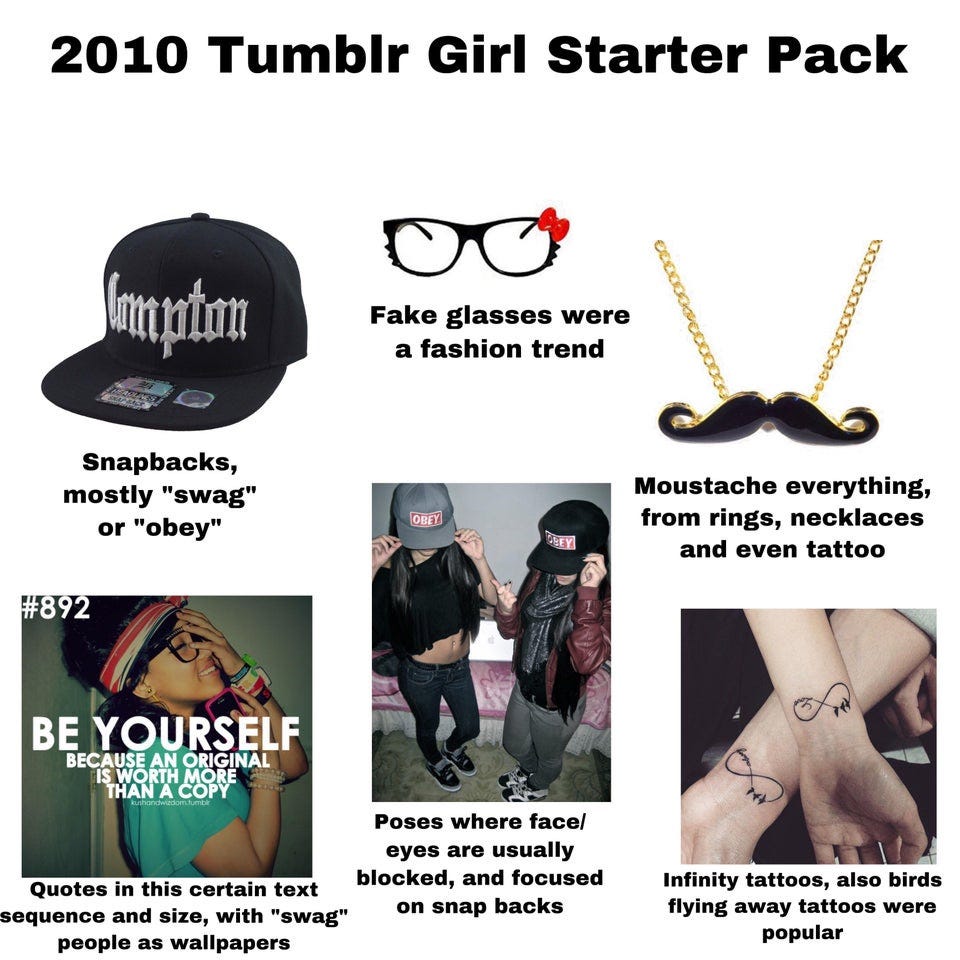
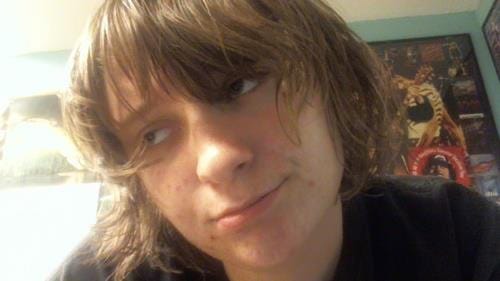
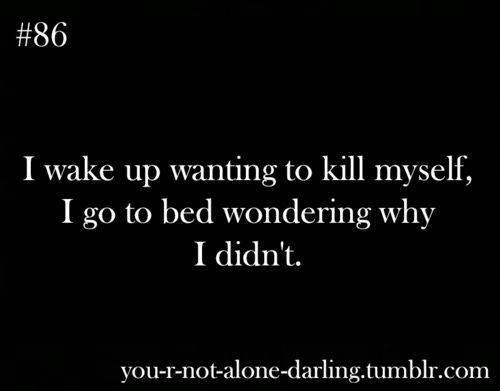
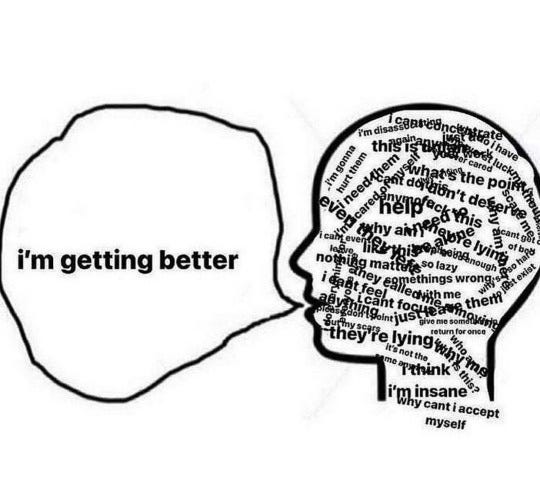
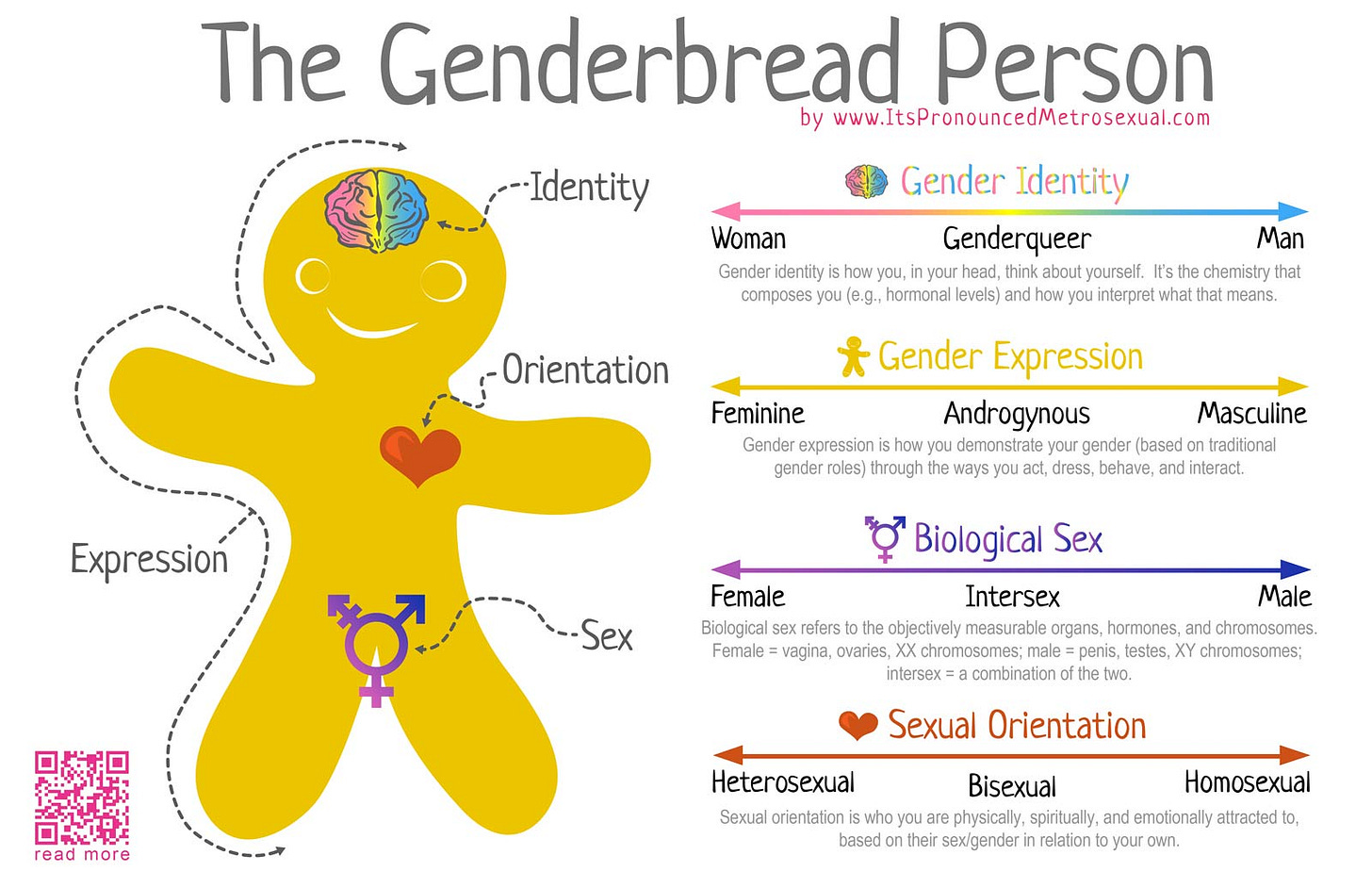
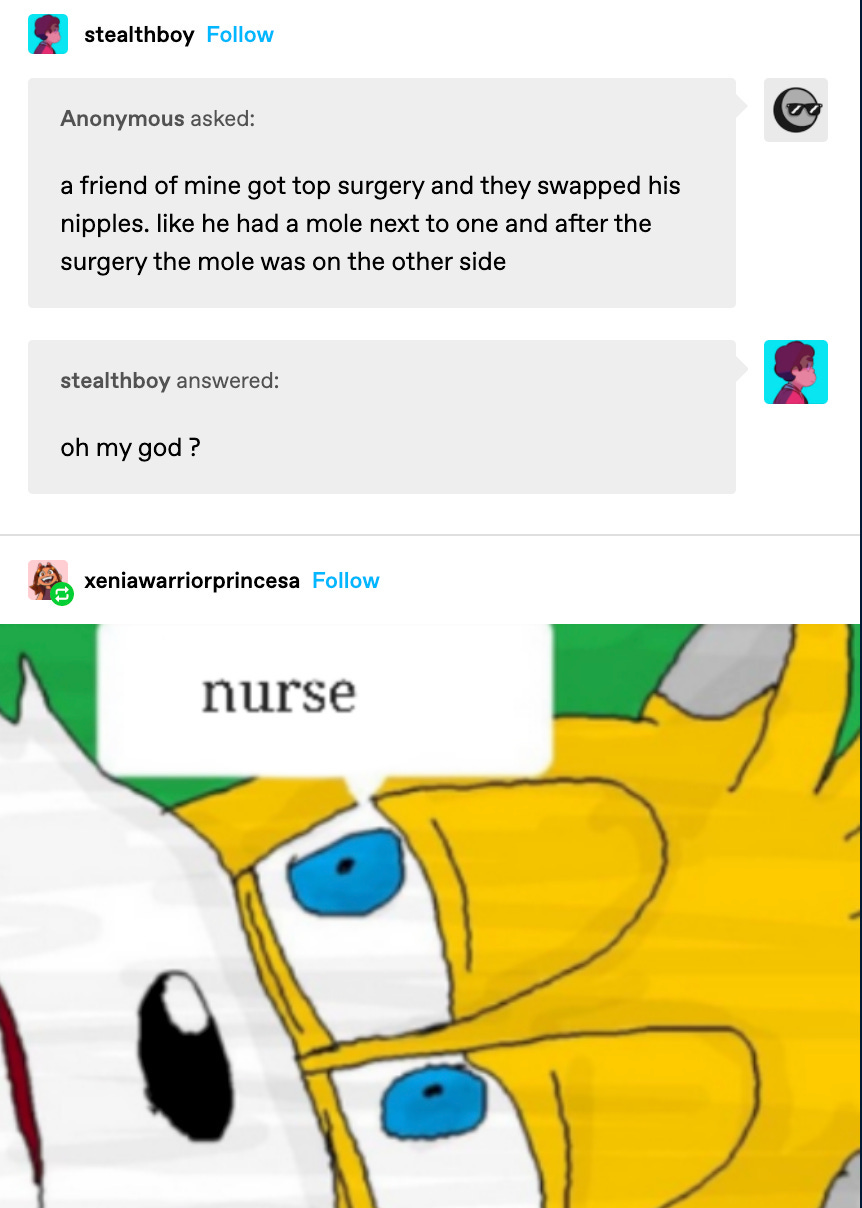
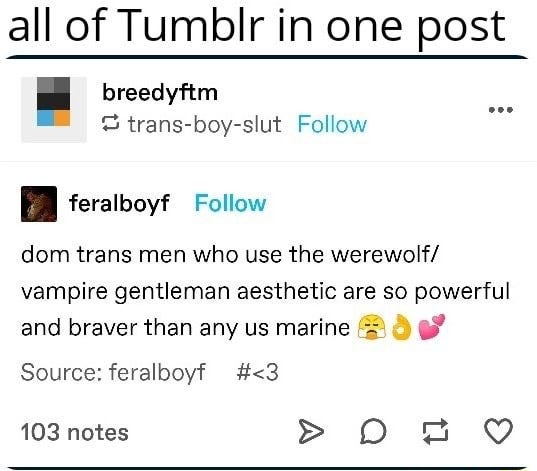
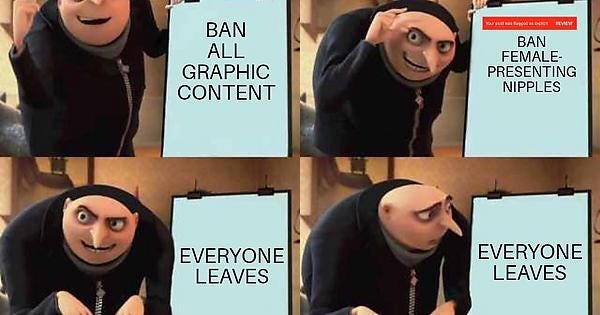


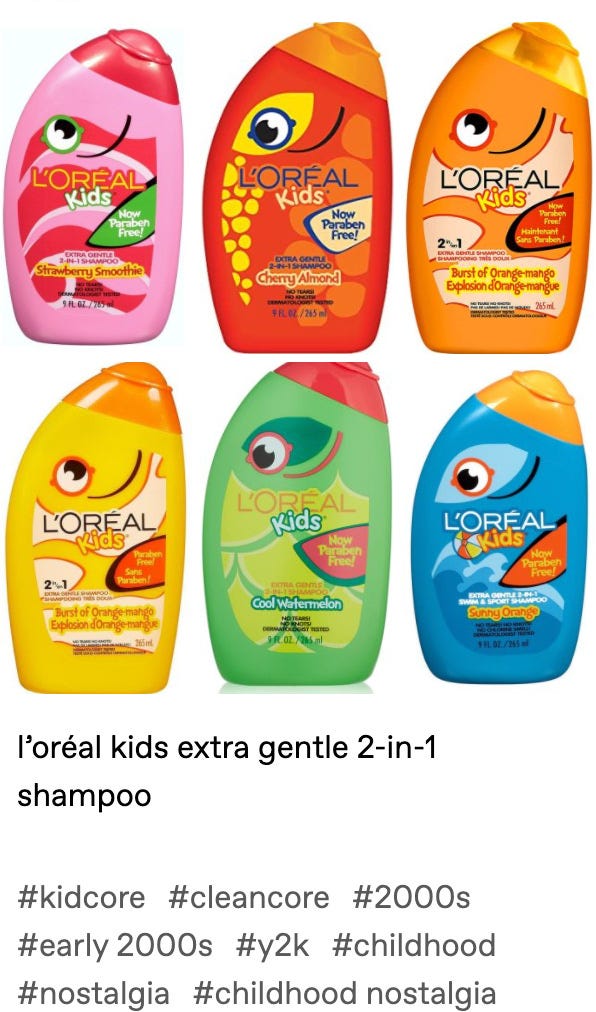
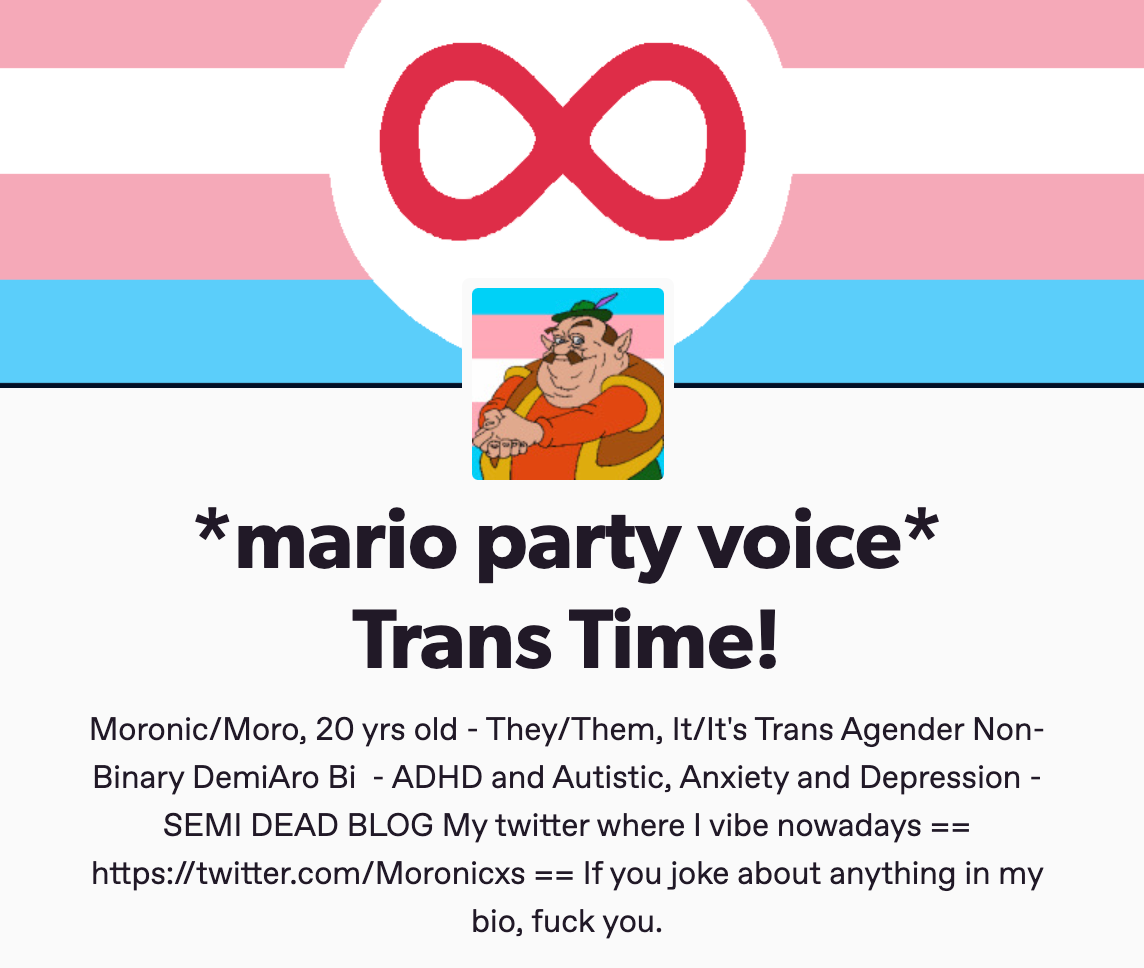
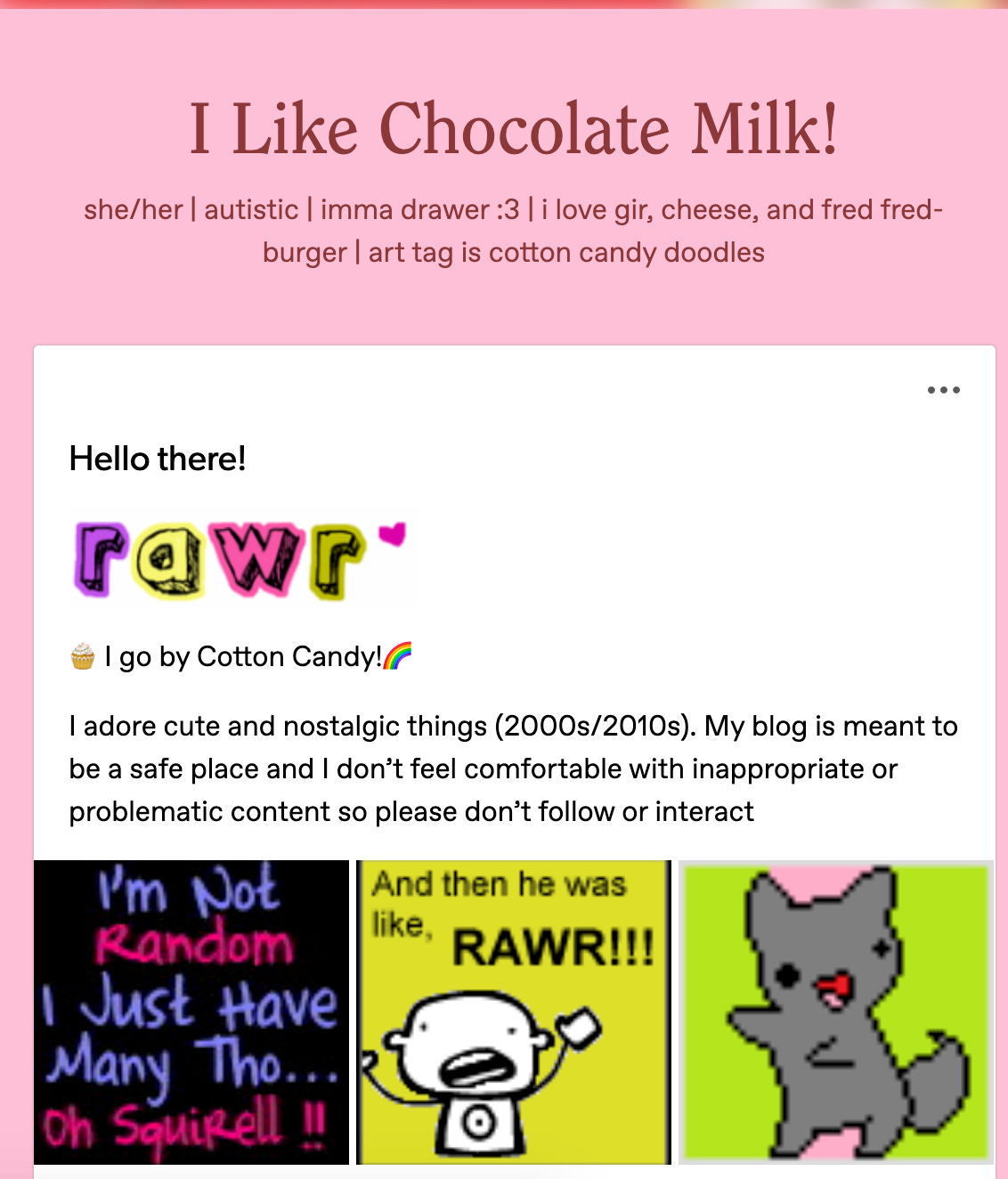


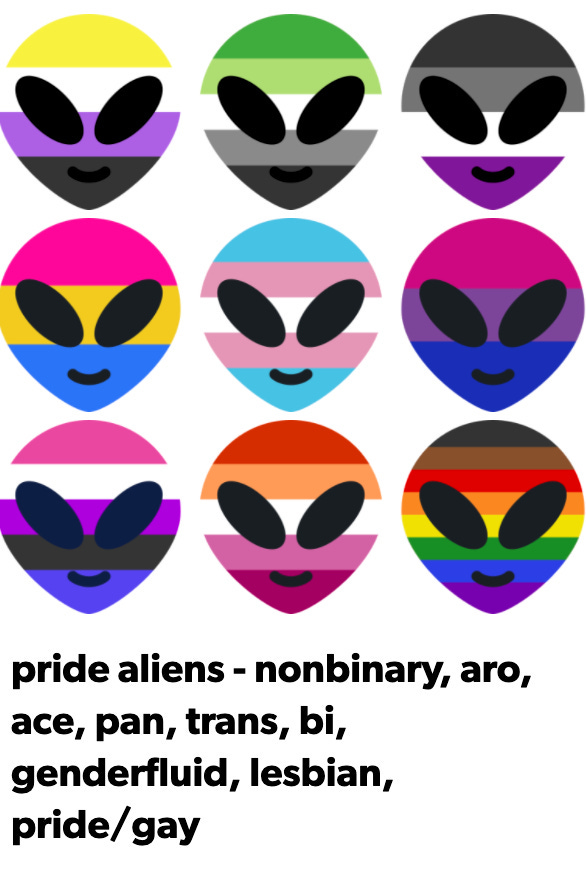
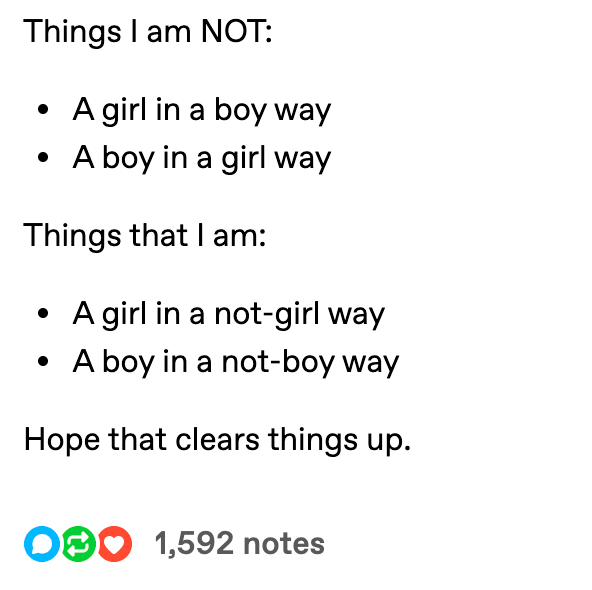
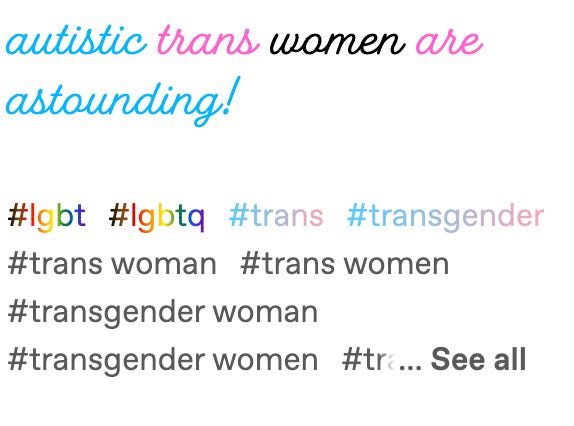
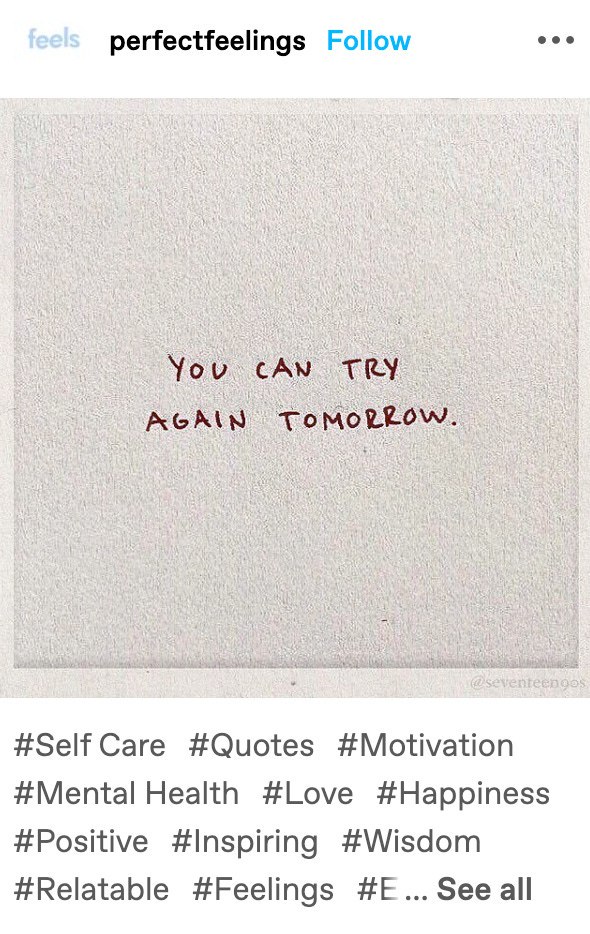
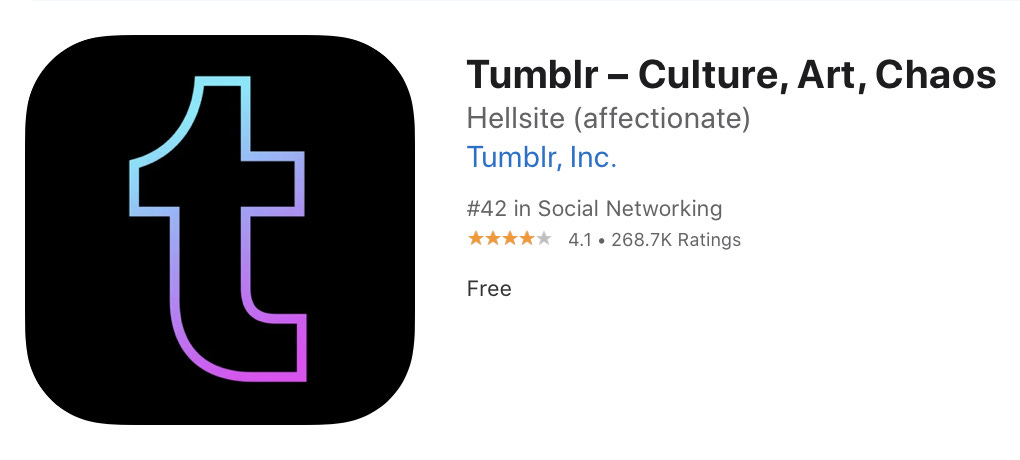
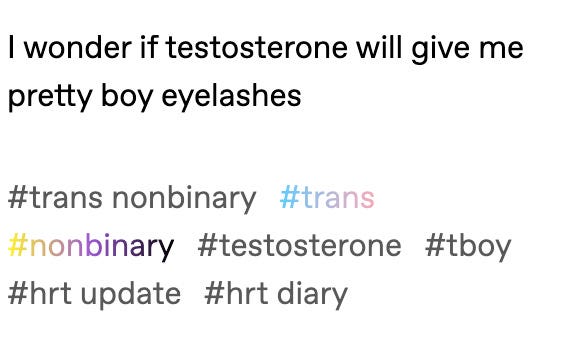
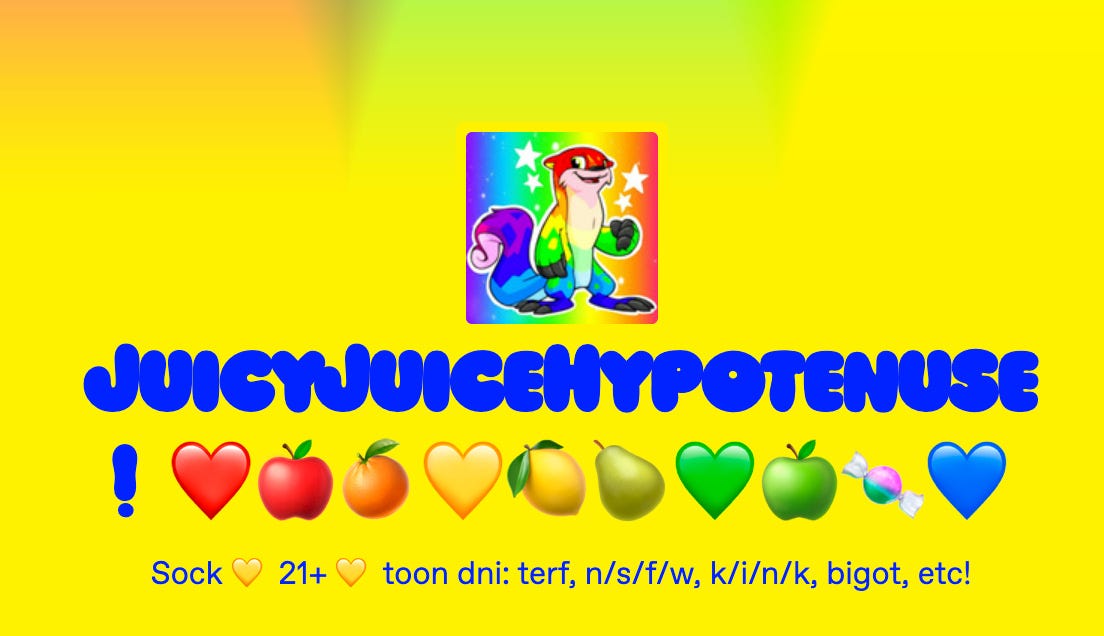

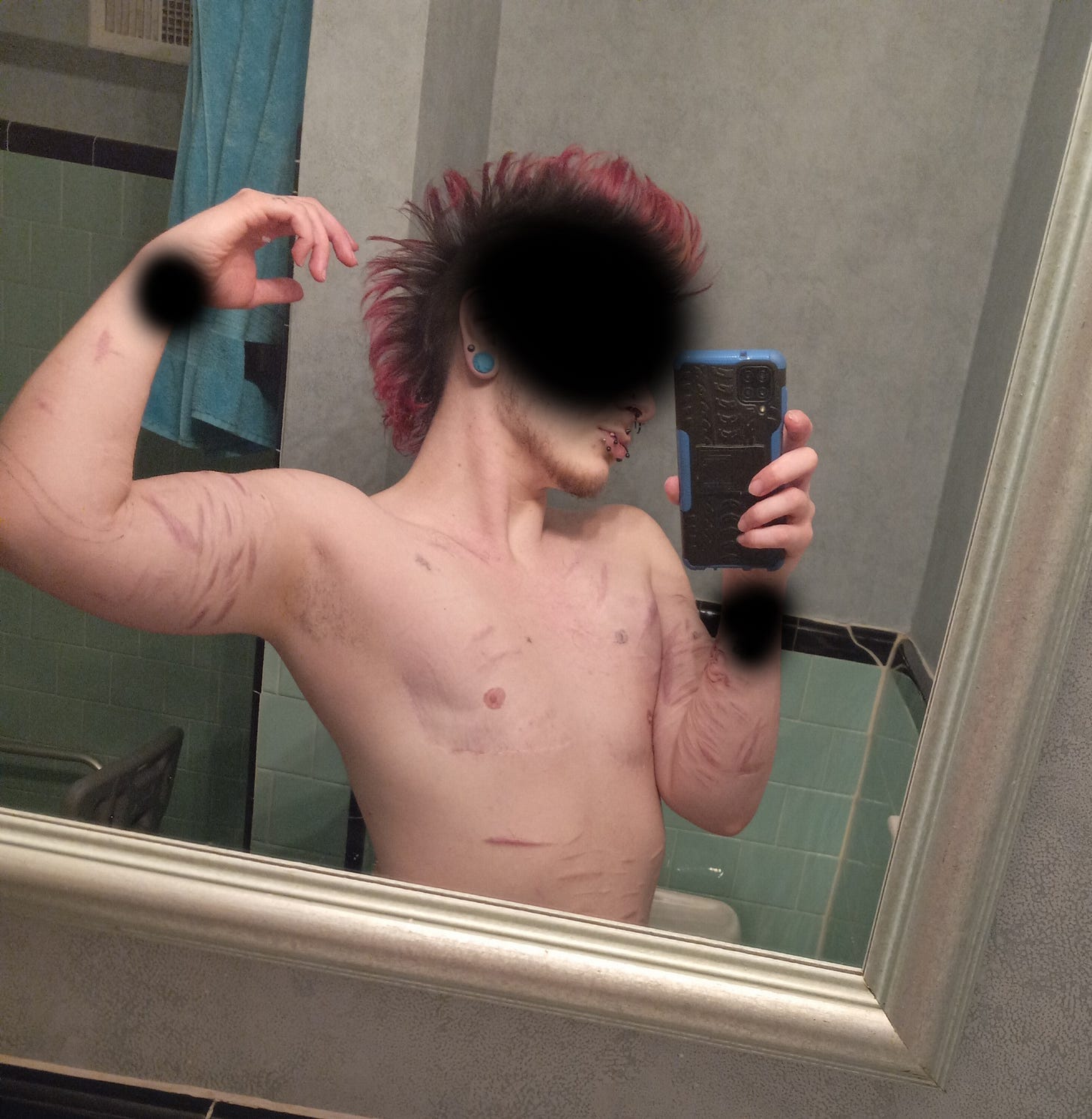

So much of this sounds eerily familiar to me, and I imagine to most autistic people. At least back then we had subcultures and aesthetics that were reversible - you can always change your hair, clothes and makeup and do different hobbies and listen to different music. And although there were absolutely social contagions of mental illness, often very dangerous ones like eating disorders and self-injury, the big difference was that CAMHS and the schools would not affirm them, and would see them as something that needed treatment and support to stop.
Or with regard to lifelong conditions like autism, the focus was on learning to manage them and improve your functioning and wellbeing as best you could. It's shameful that so many groups responsible for children's mental health and welfare have abdicated their responsibilities and are making it worse. The National Autistic Society is still on board with gender woo, even though they have been told the damage it's doing to autistic kids.
Those self-harm cutting scars ... ☹️ are in some parts of the world (namely, mine) even "celebrated" by the mainstream as a legitimate "pride" thing. Absolutely horrible.
(I am referring to this poster: https://twitter.com/Aja02537920/status/1552554421229330432)
Thank you for this informative piece Laura Funk.